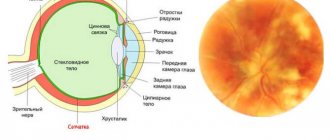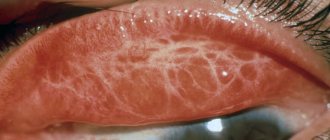Causes of red eyes in the morning
External or internal factors can cause redness and hyperemia on the proteins:
- entry of a foreign object, chlorinated water, cleaning products (shampoos, soap) into the eyes, causing irritation of the mucous membrane;
- reaction to smoke, dust, bright light, wind, dry air;
- infection;
- inflammatory processes;
- increased intracranial and blood pressure;
- diseases (uveitis, blepharitis, conjunctivitis, glaucoma, corneal ulcer, scleritis);
- staying at the computer for a long time, reading books in poor lighting;
- improper use of contact lenses, wearing inappropriate glasses frames;
- allergy;
- negative impact of split-system air conditioners, causing “dry eye syndrome”;
- poor nutrition;
- avitaminosis;
- tears containing salt, which irritates the conjunctiva;
- mechanical impact if a person constantly rubs his eyes with his hands;
- pregnancy, childbirth due to hormonal changes, fluid retention in the tear ducts.
Reference! Red eyes are observed in women during labor, when blood pressure rises sharply, capillaries expand or burst.
Unhealthy sleep
Constant lack of sleep and non-compliance with the daily routine negatively affects vision. Without rest, the eyes stick together and become inflamed in the morning.
People, in an attempt to rub their sleepy eyes after waking up, provoke:
- irritation, itching, pain, redness of the cornea;
- development of blepharitis in case of infection (staphylococcus).
Eye diseases
The list of diseases that cause inflammation and redness of the eyes is impressive:
- Acute conjunctivitis of viral and bacterial etiology. Leads to inflammation of the mucous membrane, redness of the whites of the eyes, stinging, intense tear production in case of inflammation of the inner part of the eyelid or the outer sclera.
- Uveitis (damage to the choroid). Causes: allergies, burns, eye trauma, diabetes, multiple sclerosis. Symptoms include lacrimation, photophobia, blurred vision.
- A corneal ulcer is a serious pathology that requires immediate treatment.
- Blepharitis (inflammation of the edges of the eyelids, eyelash follicles) caused by a bacterial infection, herpes simplex virus or staphylococcus. Dry eye syndrome may develop if accompanied by secondary keratoconjunctivitis.
- Episcleritis (damage to the outer layer of the sclera) accompanied by swelling of the eyelids, lacrimation, redness of the fibrous membrane, pain in the eye after waking up.
Reference! Diabetes mellitus, vegetative-vascular dystonia, and hypertensive crisis provoke redness and modification of the cornea. Only a comprehensive diagnosis will allow you to exclude or identify these diseases and prescribe the correct treatment.
Hygiene mistakes
Often girls and women go to bed with makeup on their faces. Abrasive particles of makeup getting into the eyes in the morning lead to redness, irritation, and swelling of the mucous membrane of the protein body.
Bad habits
Tobacco smoke irritates the mucous membrane. Alcohol provokes surges in intracranial pressure. After a stormy party, redness and irritation of the conjunctival mucosa are often observed in the morning.
Possible diseases
The most common causes of red eyes include diseases such as:
- Conjunctivitis, uveitis and other infectious diseases of the tissues of the organ of vision. Redness of the protein is one of the most striking symptoms. In addition, a person may complain of itching, discomfort, lacrimation and burning.
- Glaucoma. An increase in intraocular tone is fraught with a violation of the integrity of the vascular wall. As a result, in the early stages a person notices constant redness of the eyes, which does not go away even in the morning.
- General infectious diseases of the body. Flu, ARVI and colds are characterized not only by rhinitis, cough and fever. Very often the clinical picture affects the eyes: they become swollen, red, inflamed.
- Hypertension. The general increased pressure leads to the fact that the vessels cannot withstand the pressure and begin to burst. Small vessels are especially susceptible to this, in particular the capillaries of the eyes.
- Myopic disorders. Astigmatism, farsightedness and nearsightedness must be corrected using special means. Otherwise, a person receives a colossal overstrain of the eye muscles, and the result is expansion and even destruction of the fragile blood vessels of the eye.
- Allergy. Without appropriate therapy, this condition will bother a person almost around the clock. Red eyes, rhinitis, body itching are only external manifestations of the immune system fighting the allergen.
We recommend reading: Cough keeps you awake at night: what to do at home to fall asleep
Other factors
Other causes of red eyes immediately after waking up:
- ingress of dust particles or foreign bodies, which must be removed immediately regardless of size;
- sudden changes in atmospheric pressure;
- dry indoor air;
- exposure to strong winds, bright daylight;
- using poorly cleaned or unsuitable contact lenses;
- trauma, blow, scratches;
- fatigue, eyestrain after spending a long time at the computer or reading books;
- tears when a person cries for a long time;
- stress, psycho-emotional tension and perhaps need the help of a psychotherapist;
- rapid eye fatigue (sinope);
- ARVI, flu, runny nose accompanied by fever, high body temperature.
For most of the reasons listed, redness goes away quickly; it is enough to give your eyes a rest, do exercises, treat with herbal infusions or rinse with running water in the morning. But for diseases (conjunctivitis, blepharitis, glaucoma), folk remedies are unlikely to be effective. Bacterial, viral pathologies, glaucoma, inflammation of the trigeminal nerve or lymph nodes are treated exclusively under the guidance of the attending physician.
Red eyes after sleep in a child
Kids are fidgety. Redness of the eyes is often caused by:
- mechanical injury (bruise, blow);
- ingress of dirt, foreign objects, dust from the street;
- congenital conjunctivitis in case of infection entering the organ of vision through the birth canal;
- obstruction of the lacrimal canal, rupture of fragile capillaries or fragile vessels in infants in the 1st year of life;
- long exposure to the sun, watching TV;
- swimming with chlorine water getting into your eyes;
- lack of sleep, insomnia.
If there is sticking or loss of eyelashes after waking up, then blepharitis caused by Staphylococcus aureus can be suspected. If there is purulent discharge from the eyes, then the lacrimal canal is probably infected with bacteria and toxins.
A common disease is conjunctivitis:
- viral against the background of a cold, flu, acute respiratory viral infection with the discharge of purulent discharge from the eyes;
- bacterial, caused by bacteria;
- allergic, caused by an irritant allergen (fruit, berry, animal, home pillows, seasonal plants).
Breasts can get sick:
- dacryocystitis, in which the lacrimal sac becomes inflamed and purulent discharge leaves the eyes;
- marginal blepharitis with redness in the corners of the eyes;
- herpes with swelling of the eyelids, dysfunction of the lacrimal canal, germination of eyelash hairs under the eyelids.
These diseases require diagnosis and medical intervention. Self-medication is unacceptable.
What to do, how to remove redness
Therapy may turn out to be incorrect and even dangerous if you do not first find out the causes of red eyes in the morning. Of course, discomfort that does not lead to loss of vision can be relieved by simple exercises, gymnastics, and wearing special glasses to reduce eye strain. If the reason is a lack of vitamins and microelements in the body, then it is worth including foods (fruits, beef liver, carrots, blueberries) with a beneficial effect on vision in the diet.
If you are concerned about dryness or irritation of the mucous membrane, then you need to normalize your water balance and drink more clean water per day. If you are prone to allergies, you should wet clean the room more often and avoid contact with potential allergens.
Redness of the whites of the eyes in children from fatigue or overexertion is eliminated by rinsing, for example, with chamomile infusion. If the reason is the entry of a foreign body, then you should carefully pull both eyelids, try to pull them out and rinse the eye with a syringe, creating the effect of a low-pressure jet.
Dust often irritates the eyes, so it is important to ventilate the room and carry out wet cleaning. For schoolchildren, it is recommended to create good lighting in the room. The light from the lamp should fall in the place where the children spend their time doing their lessons.
Exercises
Performing simple exercises will help reduce the load on the optic nerve and prevent reddening of the whites:
- move the pupil down, left, up, right;
- make circular movements, draw figure eights with your eyes;
- blink to calm blood vessels, moisturize the cornea, and produce tears;
- close your eyes, then sharply open your eyes, up to 10 times;
- raise the pupil all the way up, hold for a few seconds;
- take a pencil, extend your right hand forward, look at the tip of the lead, then slowly move your hand to the right, tracking the object with your eyes;
- stretch your earlobes, which is effective when spending a long time at the computer;
- give rest, cover every 0.5 hours in case of overexertion.
Reference! When working sedentarily at a computer monitor, it is recommended to carry out relaxing exercises for the eyes regularly.
Drops
There are different groups of drops that are prescribed by ophthalmologists based on the diagnosis:
- antibacterial agents (Levomycetin, Sulfacyl) with a beneficial effect on capillaries and blood vessels;
- antiviral drops (Poludan, Aktipol, Oftalmoferon) for redness caused by the pathogen;
- for redness and swelling - Tobrex, Alomid, Octilia, Visin;
- when wearing lenses - Systane Ultra, Innoxa.
The most effective drops:
- Artificial tears to eliminate redness and dryness.
- Belladonna (homeopathic medicine) to relieve inflammation, photophobia.
- Arsenicum album for redness and burning, for example, with blepharitis.
- Nux Vomica, Clematis to eliminate the effects of hemorrhage.
- Apis - for swelling of the eyelids, pain.
- Alomide - to relieve redness and inflammation of the eyes caused by allergies.
- Visomitin - for eye fatigue, irritation, computer syndrome.
If redness is caused by allergies or tobacco smoke, it is recommended to use drops containing phenylephrine. For dry, overstrained eyes, drops with hyaluronic acid (Okutiarz) will help.
Reference! Broken blood vessels and hemorrhages are treated with vasoconstrictor drops. But they cannot be used for a long time due to rapid addiction.
Traditional methods
To treat red eyes at home, you can use the following recipes:
- Cold milk. Moisten a cotton-gauze bandage and apply to the eyelids to relieve itching and redness.
- Salt with an anti-inflammatory effect if the redness is caused by bacteria.
- Green tea is an antioxidant with anti-inflammatory properties. Quickly relieves redness if you apply the bag to the eyelid or drip a few drops into the lower part of the conjunctival sac.
- Cucumber. Apply a couple of cold slices to your closed eyelids.
- Aloe with a calming effect.
- Chamomile. 1 tbsp. l. Pour boiling water (1 cup) of dried flowers, leave, strain. Rinse your eyes with warm broth or drop 2-3 drops in the morning and evening.
How to deal with red eyes?
One of the most obvious answers to this question is to rule out the cause of red eyes. That is, get some sleep. However, in our case, this option is not always possible. Session, emergency at work, stormy personal life - this is not a complete list of reasons that can interfere with healthy and sound sleep. This means that eliminating the cause in our case is not always possible.
Meanwhile, red eyes do not add attractiveness to their owner, which means something needs to be done about them. Most often, vasoconstrictor eye drops are used to solve this problem. This method can bring certain results: cope with redness and return a person to a decent appearance. However, when choosing eye drops for redness, you need to think not only about the cosmetic effect, but also about how such a product will affect the organs of vision: whether it will harm and whether it can be beneficial. It is clear that no drug can replace a full 8-hour sleep. But eye redness drops can still hide the signs of lack of sleep. If, of course, you choose the right product.
Among the drugs that not only have a cosmetic effect, but also take care of the consumer’s eyes, SIGIDA crystal stands out. These eye drops can not only relieve redness, but also provide temporary relief to tired eyesight. The main active ingredient of the drug is naphazoline, which has an excellent vasoconstrictor effect. When using drops, it eliminates redness, returning the look to its usual appearance.
Also, one of the components of the drops is hyaluronic acid, which acts as a humectant and supplies the organs of vision with the moisture they need. The result of using the drops will be a clean and clear look without any signs of redness. At the same time, the eyes receive the proper degree of hydration, the muscles relax, and the risk of undesirable consequences of lack of sleep is reduced.
Of course, the problem of systematic lack of sleep cannot be solved by any drops, and in this case it is still worth finding an opportunity for proper rest of the visual organs. However, in all other cases, Sigid crystal drops can restore the eyes to their former clarity, relieve redness and provide the eyes with proper hydration. They can be called a kind of lifesaver, which should be in the arsenal of every night owl.
source
In what cases should you seek medical help?
You should immediately visit an ophthalmologist or ophthalmologist if:
- redness, swelling, pain in the eye does not go away for more than 3 days in a row;
- purulent mucous discharge is observed;
- visual acuity decreases;
- there is nausea, vomiting, headache - symptoms of high blood pressure, glaucoma.
You cannot ignore purulent discharge from the eyes, decreased clarity of vision, clouding of the cornea, and lack of reaction to light. Such signs are a reason to visit an ophthalmologist urgently.
What diagnostics
Diagnosis is carried out by a doctor based on a clinical examination, patient complaints, and a survey. Perhaps there is an allergy or diabetes mellitus, or a viral disease has been suffered.
Basic diagnostic methods:
- tear test;
- general analysis of urine and blood;
- biomicroscopy;
- visometry;
- refractometry;
- tomography;
- Schirmer's test.
A slit lamp is used to examine the surface membranes of the eyeball, as well as an ophthalmoscope, X-ray, and ultrasound device. If an allergy is suspected, patients are referred to an allergist for allergy tests.
What reasons can cause this symptom?
Injury
Timely diagnosis of red eyes is very important for recognizing serious diseases. Determining the diagnosis in the early stages of the disease significantly facilitates its treatment and prevents complications.
Determining the diagnosis in the early stages of the disease greatly facilitates its treatment and prevents the occurrence of complications.
Blepharitis
It occurs due to inflammation of neighboring areas: areas of the mouth or nose, tonsils.
Inflammatory processes on the skin also contribute to its development. Mostly it has a chronic form.
There are a number of factors influencing its change:
- Chronic infections;
- Fungus;
- Worm infestations;
- Gastrointestinal tract disorders;
- Allergy;
- Decline of immunity;
- Diabetes.
Iridocyclitis
Caused by inflammation of the iris for a number of reasons
These include: past or ongoing infectious diseases (measles, tuberculosis, gonorrhea, malaria and the like); metabolic disease.
In advanced cases, changes in the pupil and even the color of the iris are observed.
Treating diseases that may cause red eyes
- Conjunctivitis Conjunctivitis, which causes sticking of the eyelids, purulent discharge, and redness of both eyes, is treated with drops and ointments with antibiotic properties.
- Viral conjunctivitis accompanied by lacrimation, burning, photophobia - antibiotics, Interferon.
- Allergic conjunctivitis with itching, swelling of the eyelids - antihistamines.
- Uveitis with the appearance of fog, floating areas of redness of the eyes against the background of inflammation of the choroid or individual parts (ciliary body, iris) leads to blindness, and therefore requires an integrated approach to treatment.
- Ulcerative blepharitis caused by herpes simplex virus or staphylococcus - bactericidal medications, artificial tear substitutes, warm compresses to clean purulent eyelashes after waking up.
- Seasonal allergies - antiallergenic drugs (Opatanol, Lecrolin, Diazolin, Suprastin, Cromohexal, Dexamethasone, Claritin).
For children with red eyes due to a cold or infection, Tobradex or Sofradex can be instilled into the eyes. For blepharitis, local ointments and gels (Amitrazine) are used. For uveitis, immunosuppressive therapy, glucocorticosteroids, and plasmaphoresis are used.
Reference! The best remedies for redness and inflammation of the eyes due to allergies: Naphthyzin, Dexamethasone. To provide a vasoconstrictor effect, Oxial, Visin, Oftolik, Likontin are applicable. For dry eye syndrome - ointments, gels with artificial tears (Lorikacin). When wearing lenses, you can instill Emoxipin, Korneregel, Taufon to relieve irritation.
Possible complications
Inflammation of the cornea can provoke degenerative processes in the eye and the spread of lesions to other tissues. If you do not treat the underlying disease, ignore the constant redness in the eye in the morning and painful sensations, then even minor discomfort over time can lead to:
- dry mucous membranes;
- blurred vision;
- development of chronic inflammation, serious ophthalmological diseases (blepharitis, uveitis, cataracts, malignant tumor).
Worth knowing! Banal redness of the eyes with complications leads to the development of cataracts and complete blindness.
What is the threat?
So, without resting for the allotted time, in the morning a person sees red eyes in the mirror from lack of sleep. Their fatigue and excessive dryness cause discomfort. A person is forced to blink and squint frequently. This, in turn, leads to the formation of expression lines around the eyes. Such consequences are very upsetting for women, and men are unlikely to like them either.
The quality of vision deteriorates - a person sees equally poorly near and far and he has to strain to see an object. This tension can cause headaches. If the lack of sleep is not temporary, but permanent, it can lead to deterioration of vision. Accordingly, dry and tired eyes are one of the reasons for vision deterioration. What should you do to avoid having to see an ophthalmologist in the very near future?
Preventive measures
Eliminating the consequences of eye diseases is difficult, so it is always easier to prevent:
- clean your eyes before going to bed;
- review your diet and lifestyle;
- eliminate bad habits;
- give your eyes rest during frequent, long periods of time at the computer;
- carry out wet cleaning more often;
- use high-quality cosmetics, rinsing off before bed;
- do exercises to train the muscular system of the eyes;
- relax, closing your eyelids for a few seconds;
- observe the rules of personal hygiene;
- do not rub your eyes with dirty hands.
If your eyes regularly become inflamed or red after waking up, you should consult an ophthalmologist. You cannot treat eye diseases on your own.
Watch a video about ways to get rid of red eyes:
Prevention
To avoid red eyes, you must:
- protect them from dust and litter by wearing glasses;
- give the organ rest;
- eat more yellow or orange fruits and vegetables;
- avoid flour and sweets in the menu;
- do gymnastics regularly;
- use only high-quality cosmetics;
- observe the rules of hygiene.
A healthy lifestyle and strong immunity contribute to the normal functioning of the visual organ. Redness or hyperemia on the whites of the conjunctiva of the eye is quite common in the morning. This can be either a temporary phenomenon or a symptom of a serious illness that needs to be urgently diagnosed and treated.











